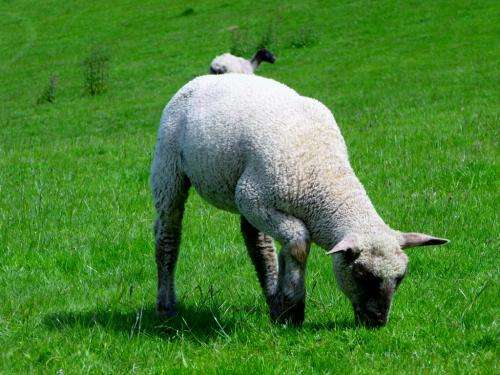Sheep feed on grasses, which contain little pieces of crystals known as silica, making their teeth subject to very high wear conditions. Credit: grassrootsgroundswell
A first-ever study investigating the survival of ovine teeth has found the stiffness (Young's modulus) and hardness of sheep molar enamel is lower than that of human molar enamel, while the toughness of sheep enamel is the same as a human molar enamel.
The study between researchers from UWA and Edith Cowan University compared the structure of ovine molar teeth, collected postmortem from an adult sheep, to human molar teeth extracted from three patients aged 20–30 years of age.
To model the fracture behaviour of ovine teeth, the researchers measured the geometrical (height, enamel thickness) and mechanical properties (stiffness and toughness of enamel) of the dental tissues using a method known as nanoindentation.
UWA School of Mechanical and Chemical Engineering Emeritus Professor Mark Bush says there is almost no information about the dental tissue properties of enamel and dentin (softer interior of the tooth) in any mammals other than humans.
"Modeling the fracture behaviour of sheep teeth can aid in our understanding of the maximum biting force the animal is capable of producing," E/Prof Bush says.
He says the increased toughness and reduced hardness and stiffness in sheep's enamel may be linked to the need for wear resistance given the nature of their diet.
"Sheep feed on grasses, which contain little pieces of crystals known as silica," he says.
"They also tend to pick grass from the sand and often end up grinding those grains between their teeth, making their teeth subject to very high wear conditions."
E/Prof Bush says as the animal starts to feed on grass, it shears the top of the tooth – the crown, which is very thin – leaving sharp exposed ridges of enamel around the edges and across the centre of the tooth.
"In order to keep these edges sharp, the animal has to constantly wear its tooth down," he says.
As the height of a sheep's molar teeth is about seven or eight times taller than the diameter of its tooth, E/Prof Bush says most of its tooth forms inside the bone of the jaw.
He says that as the tooth is worn down, the remaining of the untouched tooth gets jacked up.
However, he says the wear rate must not be so high that the functional life of sheep's tooth is shorter than that required for the animal to mature and reproduce.
Thus the researchers found that unlike the human molars, which is prone to damage by fracture, the dominant challenge to the survival of sheep molars is wear rather than fracture.
More information: "Revealing the structural and mechanical characteristics of ovine teeth." O'Brien S, et al. J Mech Behav Biomed Mater. 2014 Feb;30:176-85. DOI: 10.1016/j.jmbbm.2013.11.006. Epub 2013 Nov 19.
Provided by Science Network WA























